Edelstein-Keshet L. Mathematical Models in Biology
Подождите немного. Документ загружается.

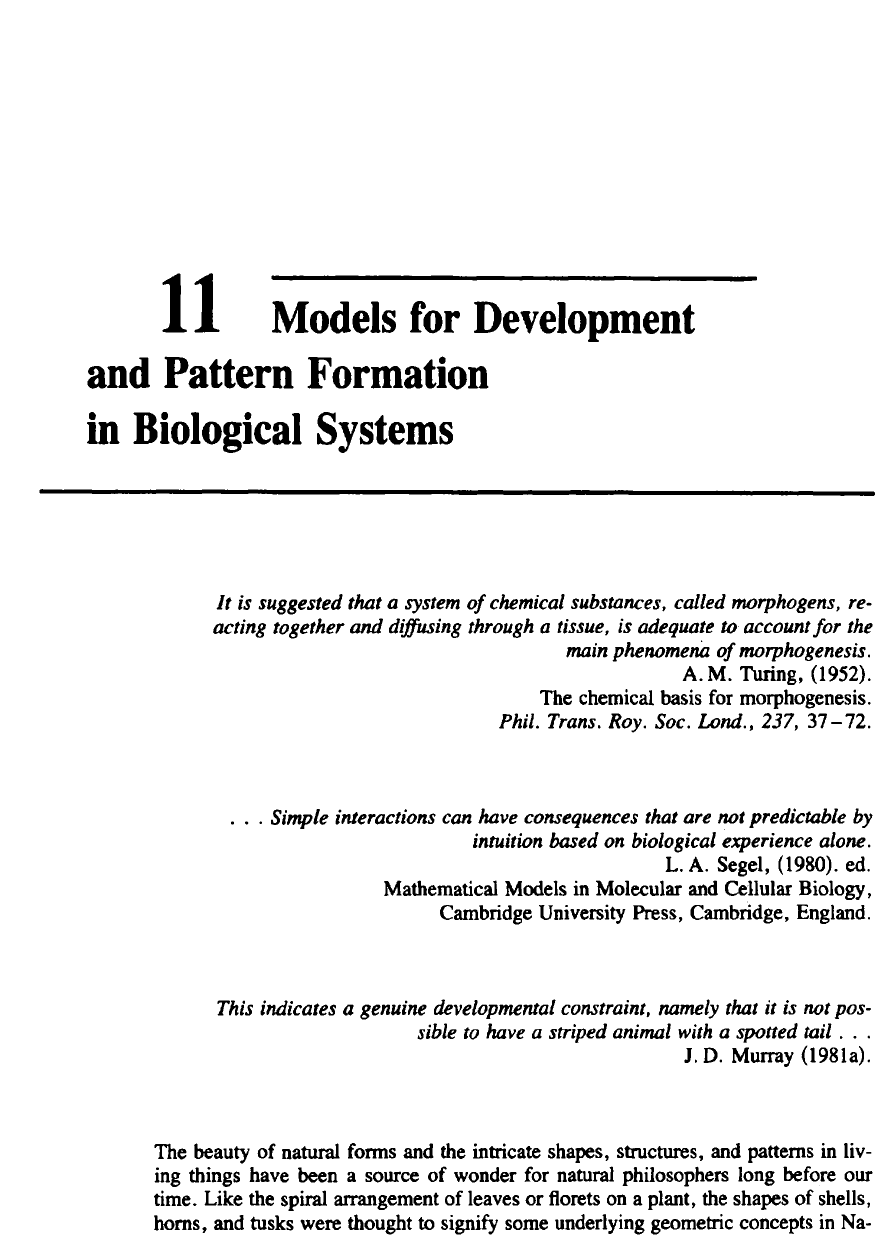
Models
for
Development
and
Pattern
Formation
in
Biological
Systems
It is
suggested that
a
system
of
chemical
substances,
called
morphogens,
re-
acting
together
and
diffusing
through
a
tissue,
is
adequate
to
account
for the
main
phenomena
of
morphogenesis,
A.M. Turing, (1952).
The
chemical basis
for
morphogenesis.
Phil. Trans. Roy. Soc. Lond., 237,
37-72.
.
Simple interactions
can
have consequences that
are not
predictable
by
intuition
based
on
biological
experience
alone.
L.A.
Segel,
(1980).
ed.
Mathematical Models
in
Molecular
and
Cellular Biology,
Cambridge
University Press, Cambridge, England.
This
indicates
a
genuine
developmental
constraint,
namely
that
it is not
pos-
sible
to
have
a
striped
animal with
a
spotted
tail
. . .
J.D. Murray (1981a).
The
beauty
of
natural forms
and the
intricate shapes, structures,
and
patterns
in
liv-
ing
things have been
a
source
of
wonder
for
natural
philosophers
long before
our
time. Like
the
spiral
arrangement
of
leaves
or florets on a
plant,
the
shapes
of
shells,
horns,
and
tusks were thought
to
signify
some underlying geometric concepts
in Na-
11
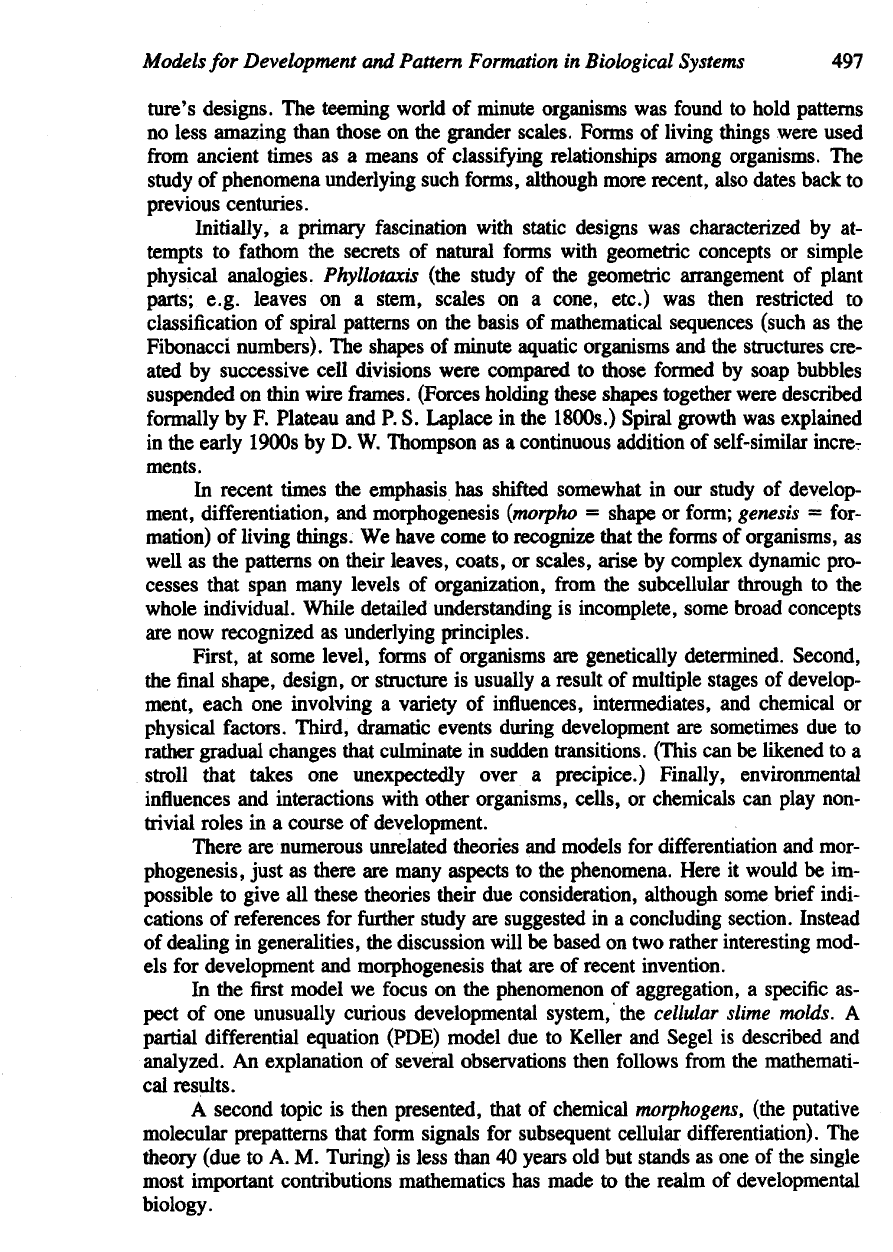
Models
for
Development
and
Pattern Formation
in
Biological
Systems
497
ture's
designs.
The
teeming world
of
minute organisms
was
found
to
hold patterns
no
less
amazing than those
on the
grander scales. Forms
of
living things were used
from
ancient times
as a
means
of
classifying relationships among organisms.
The
study
of
phenomena underlying such forms, although more recent, also dates back
to
previous centuries.
Initially,
a
primary fascination with static designs
was
characterized
by at-
tempts
to
fathom
the
secrets
of
natural
forms
with geometric concepts
or
simple
physical analogies. Phyllotaxis (the study
of the
geometric arrangement
of
plant
parts; e.g. leaves
on a
stem,
scales
on a
cone, etc.)
was
then restricted
to
classification
of
spiral patterns
on the
basis
of
mathematical sequences
(such
as the
Fibonacci numbers).
The
shapes
of
minute aquatic organisms
and the
structures cre-
ated
by
successive cell divisions were compared
to
those
formed
by
soap bubbles
suspended
on
thin wire frames. (Forces holding these shapes together were described
formally
by F.
Plateau
and P. S.
Laplace
in the
1800s.)
Spiral growth
was
explained
in
the
early
1900s
by D. W.
Thompson
as a
continuous addition
of
self-similar incre-
ments.
In
recent times
the
emphasis
has
shifted somewhat
in our
study
of
develop-
ment,
differentiation,
and
morphogenesis
(morpho
=
shape
or
form;
genesis
—
for-
mation)
of
living things.
We
have come
to
recognize that
the
forms
of
organisms,
as
well
as the
patterns
on
their
leaves,
coats,
or
scales, arise
by
complex dynamic pro-
cesses
that span many levels
of
organization,
from
the
subcellular through
to the
whole individual. While
detailed
understanding
is
incomplete, some broad concepts
are
now
recognized
as
underlying principles.
First,
at
some
level,
forms
of
organisms
are
genetically determined. Second,
the
final
shape, design,
or
structure
is
usually
a
result
of
multiple stages
of
develop-
ment, each
one
involving
a
variety
of
influences, intermediates,
and
chemical
or
physical factors. Third, dramatic events during development
are
sometimes
due to
rather gradual changes that culminate
in
sudden transitions. (This
can be
likened
to a
stroll that takes
one
unexpectedly over
a
precipice.) Finally, environmental
influences
and
interactions with other organisms,
cells,
or
chemicals
can
play non-
trivial
roles
in a
course
of
development.
There
are
numerous unrelated theories
and
models
for
differentiation
and
mor-
phogenesis,
just
as
there
are
many
aspects
to the
phenomena. Here
it
would
be im-
possible
to
give
all
these theories their
due
consideration, although some brief indi-
cations
of
references
for
further
study
are
suggested
in a
concluding section. Instead
of
dealing
in
generalities,
the
discussion will
be
based
on two
rather interesting mod-
els for
development
and
morphogenesis that
are of
recent invention.
In the first
model
we
focus
on the
phenomenon
of
aggregation,
a
specific
as-
pect
of one
unusually curious developmental system,
the
cellular
slime
molds.
A
partial differential equation (PDE) model
due to
Keller
and
Segel
is
described
and
analyzed.
An
explanation
of
several observations then follows
from
the
mathemati-
cal
results.
A
second topic
is
then presented, that
of
chemical
morphogens,
(the putative
molecular prepatterns that
form
signals
for
subsequent cellular differentiation).
The
theory (due
to A. M.
Turing)
is
less
than
40
years
old but
stands
as one of the
single
most important contributions mathematics
has
made
to the
realm
of
developmental
biology.

498
Spatially
Distributed
Systems
and
Partial
Differential
Equation
Models
While these topics
are
somewhat more advanced
than
those
in the
earlier chap-
ters
of
this book,
a
number
of
factors combine
to
motivate their inclusion. From
the
pedagogic
point
of
view, these
are
good illustrations
of
some analysis
of PDE
mod-
els. (While
the
analysis
falls
short
of
actually solving
the
equations
in
full
generality,
it
nevertheless reveals interesting
results.)
Furthermore, techniques
of
linear stability
methods,
and the
important concepts
of
gradual parameter variations (which
are fa-
miliar
to the
reader)
are
reapplied here. (Although certain subtleties
may
require
some guidance,
the
underlying philosophy
and
basic steps
are the
same.) This then
is
a final
"variation
on a
theme" that threads
it way
through
the
approach
to the
three
distinctly
different
types
of
models (discrete, continuous,
and
spatially distributed).
Even more
to the
point,
the
models presented here
are
examples
of
genuine
in-
sight that mathematics
can
contribute
to
biology. These case studies point
to
funda-
mental issues that would
be
difficult,
if not
impossible,
to
resolve based
on
verbal
arguments
and
biological intuition alone. These examples reinforce
the
belief that
theory
may
have
an
important role
to
play
in the
biological sciences.
The
chapter
is
organized
as
follows: Sections 11.1
to
11.3
are
devoted
to the
problem
of
aggregation.
In
particular, Section 11.2 introduces
the
methods
of
ana-
lyzing
(spatially nommiform) deviations
from
a
(uniform)
steady state. Readers
who
have
not
covered Chapters
9 and 10 in
full
detail
can
nevertheless
follow
this analy-
sis
provided that
the
equations
of the
model
are
motivated
and
that
the
form
of the
perturbations given
by
equations (9a,b)
is
taken
at
face
value.
Sections
11.4
and
11.5 then introduce
reaction-diffusion
systems
and
chemical
morphogens.
The
general model requires
a
very cursory
familiarity
with
the
diffu-
sion equation
(or
faith
that
the
special
choice
of
perturbations given
by
equation (27)
are
appropriate;
see
motivation
in
Section 11.2). Further analysis
is
essentially
straightforward
given familiarity with Taylor
series,
eigenvalues,
and
characteristic
equations.
(A
somewhat novel feature encountered
is
that
the
growth rate
cr
of
per-
turbations depends
on
their spatial
"waviness"
q.) It is
possible
to
omit
the
details
of
the
derivation leading
up to the
conditions
for
diffusive
instability, (32a,b)
and
(38),
in
the
interest
of
saving time
or
making
the
material more accessible. Section 11.6
is
an
important
one in
which
we use
simple logical deductions
to
make physically
in-
teresting statements based
on the
conditions derived
in the
preceding analysis.
The
concepts
in
Section 11.7
are
more subtle
but
lead
to an
appreciation
of the
role
of the
domain
size
on the
chemical patterns. Implications
for
morphogenesis
and for
other
systems
are
then given
in
Sections 11.8
and
11.9.
11.1 CELLULAR SLIME MOLDS
Despite
their mildly
repelling
name, slime molds
are
particularly fascinating crea-
tures
offering
an
extreme example
of
"split
personality."
In its
native state
a
slime
mold population might consist
of
hundreds
or
thousands
of
unicellular amoeboid
cells.
Each
one
moves independently
and
feeds
on
bacteria
by
phagocytosis
(i.e.
by
engulfing
its
prey). There
are
many species
of
slime molds commonly encountered
in
the
soil;
one of the
most frequently studied
is
Dictyostelium
discoideum.

Models
for
Development
and
Pattern
Formation
in
Biological
Systems
499
When
food bec s scarce,
the
amoebae enter
a
phase
of
starvation
and an in-
teresting sequence
of
events ensues. First,
an
initially
uniform
cell distribution
de-
velops what appear
to be
centers
of
organization called
aggregation
sites. Cells
are
attracted
to
these loci
and
move towards them,
often
in a
pulsating, wavelike man-
ner. Contacts begin
to
form
between neighbors,
and
streams
of
cells
converge
on a
single site, eventually forming
a
shapeless multicellular mass.
The
aggregate under-
goes curious contortions
in
which
its
shape changes several
times. For a
while
it
takes
on the
appearance
of a
miniature slug that moves about
in a
characteristic way.
The
cells
making
up the
forward
portion become somewhat
different
biochemically
from
their
colleagues
in the
rear. Already
a
process
of
differentiation
has
occurred;
if
left
undisturbed
the two
cell types (called
prespore
and
prestalk)
will
have quite dis-
tinct
fates:
Anterior cells
turn
into stalk cells while posterior cells become spores.
At
this stage
the
differentiation
of the
multicellular mass
is as yet
reversible.
A
fascinating
series
of
experiments (see
box in
Section 11.3)
has
been carried
out to
demonstrate that
the
ratio
of the two
cell
types
is
self-regulating;
if a
portion
of the
slug
is
excised, some
of the
cells change their apparent type
so as to
preserve
the
proper ratio.
The
sluglike collection
of
cells executes
a
crawling motion; understanding
of
the
underlying mechanism
is
just beginning
to
emerge (see Odell
and
Bonner,
1986).
It
then undertakes
a
sequence
of
shapes including that
of a
dome.
As a
culmi-
nation
of
this amazing sequence
of
events, cellular streaming resembling
a
"reverse
fountain"
brings
all
prestalk cells around
the
outside
and
down through
the
center
of
the
mass.
The
result
is a
slender, beautifully sculptured stalk bearing
a
spore-filled
capsule
at its
top.
In
order
to
provide
a rigid
structural basis,
the
stalk cells harden
and
eventually die.
The
spore
cells
are
thereby provided with
an
opportunity
to
sur-
vive
the
harsh conditions,
to be
dispersed
by air
currents,
and to
thus propagate
the
species into more favorable environments. Since individual slime mold cells
do not
reproduce
after
the
onset
of
aggregation, there
is
always some fraction
of the
popula-
tion
that
is
destined
to die as
part
of the
structural material. (There
is a
natural ten-
dency
to
view this anthropomorphically
as an
example
of
self-sacrifice
for the
group
interest.)
Slime molds have fascinated biologists
for
many decades,
not
simply
for
their
amazing
repertoire,
but
also because
of
their easily accessible
and
malleable devel-
opmental system. There
are
many intriguing questions
to be
addressed
in
under-
standing
the
complicated
social
behavior
of
this population
of
relatively primitive
or-
ganisms.
To
outline just
a few
theoretical questions, consider:
1.
What causes
cells
to
aggregate,
and how do
cells "know" where
an
aggregation
center should
form?
2.
What mechanisms underly motion
in the
slug?
3.
What determines
the
prespore-prestalk commitment,
and how is the
ratio
controlled? (This
is a
problem
of
size regulation
in a
pattern.)
4. How are
cells
sorted
so
that prestalk
and
prespore cells
fall
into appropriate
places
in the
structure?
5.
What forces lead
to the
formation
of a
variety
of
shapes including that
of the
final
sporangiophore
(the spore-bearing structure)?
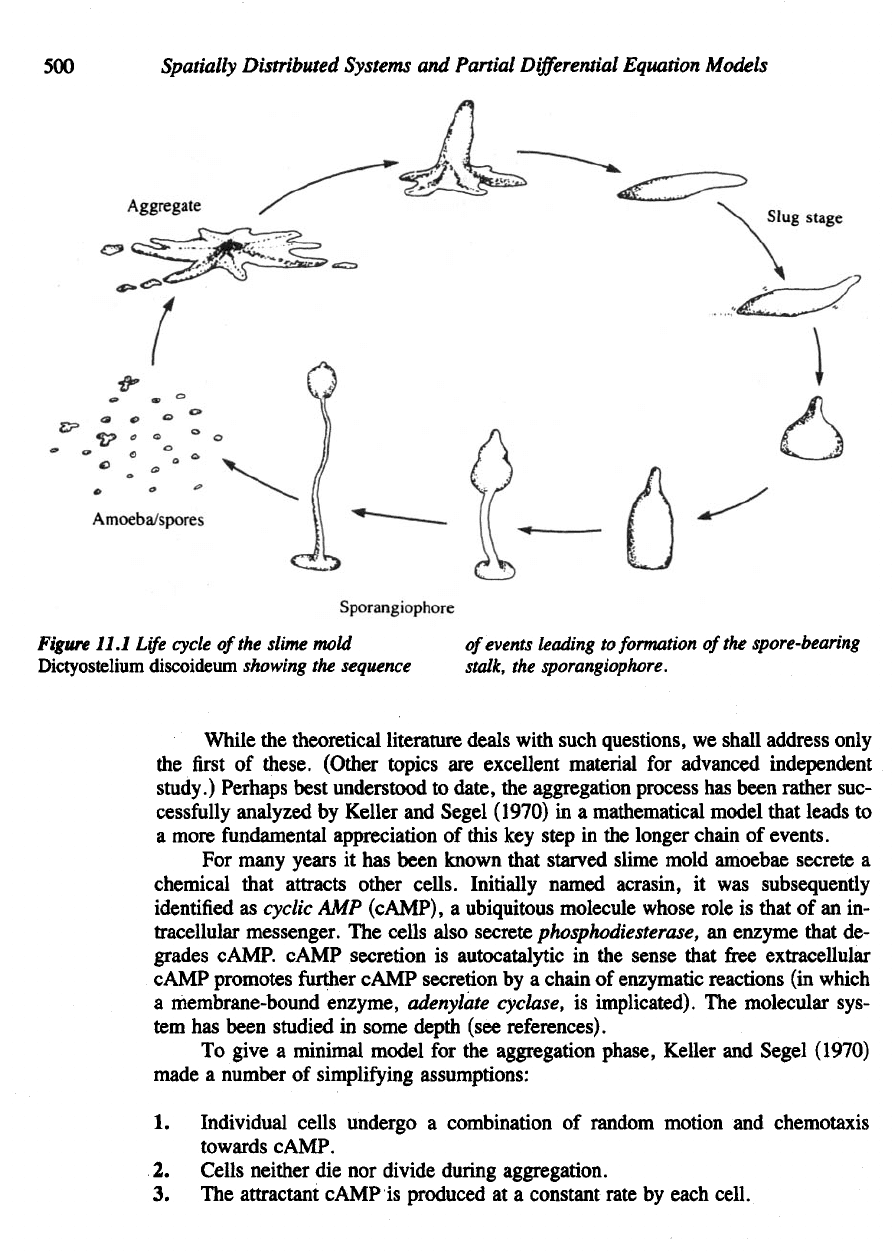
500
Spatially
Distributed
Systems
and
Partial
Differential
Equation
Models
Figure
11.1
Life
cycle
of
the
slime mold
Dictyostelium
discoideum
showing
the
sequence
of
events leading
to
formation
of
the
spore-bearing
stalk,
the
sporangiophore.
While
the
theoretical literature deals with such questions,
we
shall address only
the
first
of
these. (Other topics
are
excellent material
for
advanced independent
study.)
Perhaps
best
understood
to
date,
the
aggregation process
has
been rather suc-
cessfully
analyzed
by
Keller
and
Segel (1970)
in a
mathematical model that leads
to
a
more fundamental appreciation
of
this
key
step
in the
longer chain
of
events.
For
many years
it has
been known that starved slime mold amoebae secrete
a
chemical that attracts other
cells.
Initially named acrasin,
it was
subsequently
identified
as
cyclic
AMP
(cAMP),
a
ubiquitous molecule whose role
is
that
of an in-
tracellular messenger.
The
cells
also secrete
phosphodiesterase,
an
enzyme that
de-
grades cAMP. cAMP secretion
is
autocatalytic
in the
sense that
free
extracellular
cAMP promotes
further
c AMP
secretion
by a
chain
of
enzymatic reactions
(in
which
a
membrane-bound enzyme,
adenylate
cyclase,
is
implicated).
The
molecular sys-
tem
has
been studied
in
some depth (see references).
To
give
a
minimal model
for the
aggregation phase, Keller
and
Segel
(1970)
made
a
number
of
simplifying assumptions:
1.
Individual cells undergo
a
combination
of
rando motion
and
chemotaxis
towards cAMP.
2.
Cells neither
die nor
divide during aggregation.
3. The
attractant
c
AMP
is
produced
at a
constant rate
by
each
cell.
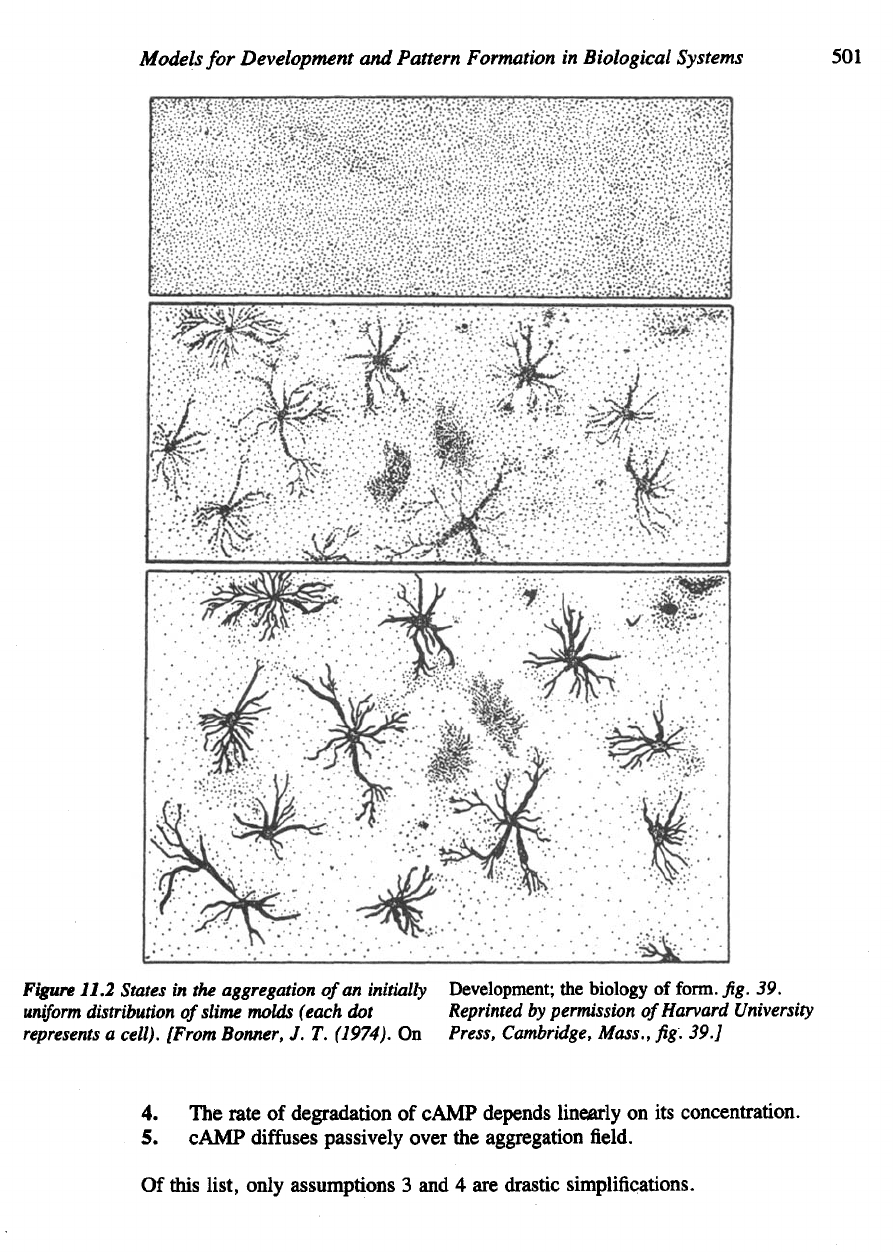
Models
for
Development
and
Pattern Formation
in
Biological
Systems
501
Figure
11.2
States
in the
aggregation
of
an
initially Development;
the
biology
of
form.
fig. 39.
uniform
distribution
of
slime molds (each
dot
Reprinted
by
permission
of
Harvard University
represents
a
cell). [From
Banner,
J. T.
(1974).
On
Press, Cambridge,
Mass.,
fig.
39.]
4. The
rate
of
degradation
of
cAMP depends linearly
on its
concentration.
5.
cAMP
diffuses
passively over
the
aggregation
field.
Of
this
list,
only assumptions
3 and 4 are
drastic simplifications.
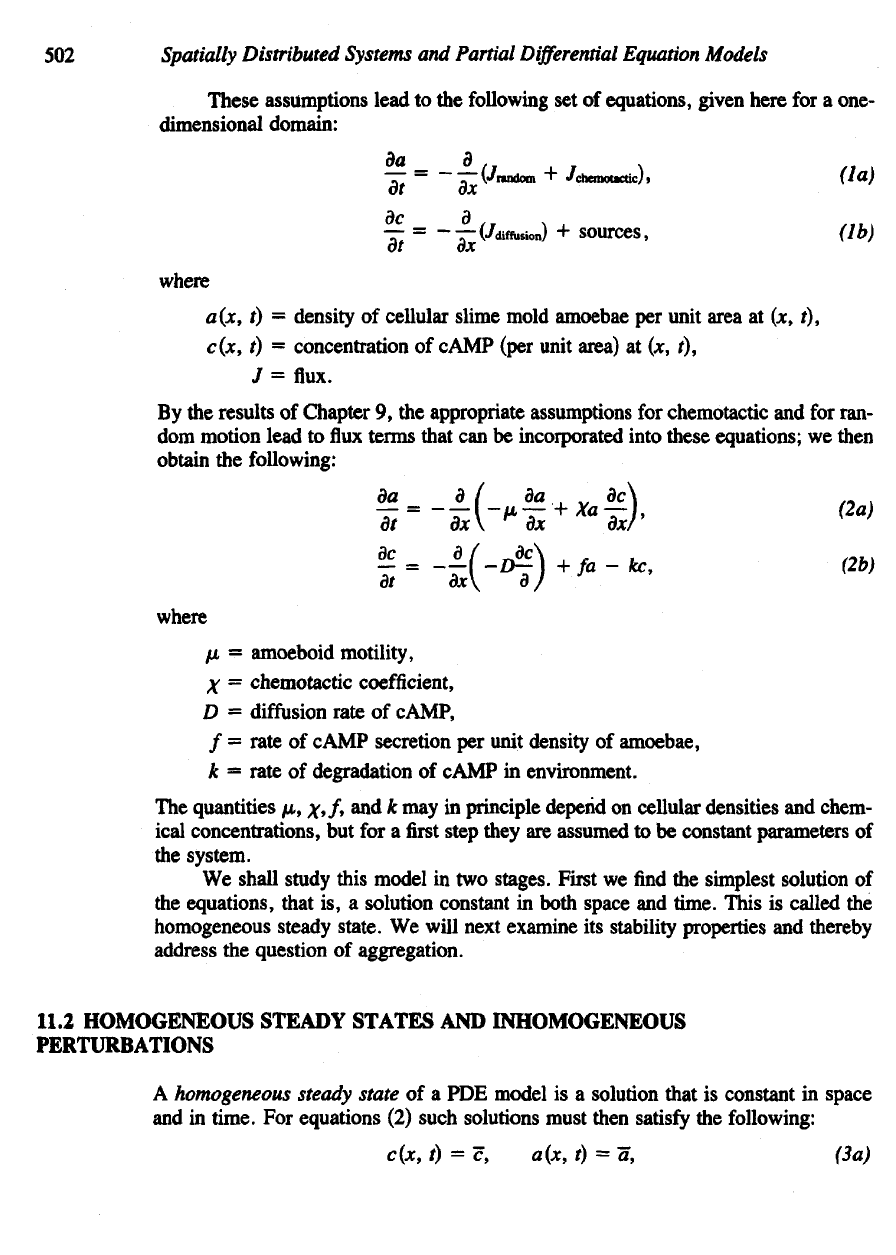
502
Spatially
Distributed
Systems
and
Partial
Differential
Equation
Models
These assumptions lead
to the
following
set of
equations, given here
for a
one-
dimensional domain:
where
a(x,
t) =
density
of
cellular slime mold am bae
per
unit area
at
(jc,
t),
c(x,
t) =
concentration
of
cAMP (per
unit
area)
at (*, /),
J
= flux.
By
the
results
of
Chapter
9, the
appropriate assumptions
for
chemotactic
and for ran-
dom
motion lead
to flux
terms that
can be
incorporated into these equations;
we
then
obtain
the
following:
where
fji
—
amoeboid motility,
X
=
chemotactic coefficient,
D
=
diffusion
rate
of
cAMP,
/ =
rate
of
cAMP secretion
per
unit density
of
amoebae,
k
=
rate
of
degradation
of
cAMP
in
environment.
The
quantities
fJL,
\,f,
and k may in
principle depend
on
cellular densities
and
chem-
ical concentrations,
but for a first
step they
are
assumed
to be
constant parameters
of
the
system.
We
shall study this model
in two
stages. First
we find the
simplest solution
of
the
equations, that
is, a
solution constant
in
both space
and
time. This
is
called
the
homogeneous steady state.
We
will next examine
its
stability properties
and
thereby
address
the
question
of
aggregation.
11.2 HOMOGENEOUS STEADY STATES
AND
INHOMOGENEOUS
PERTURBATIONS
A
homogeneous
steady
state
of a PDE
model
is a
solution that
is
constant
in
space
and
in
time.
For
equations
(2)
such solutions
must
then
satisfy
the
following:
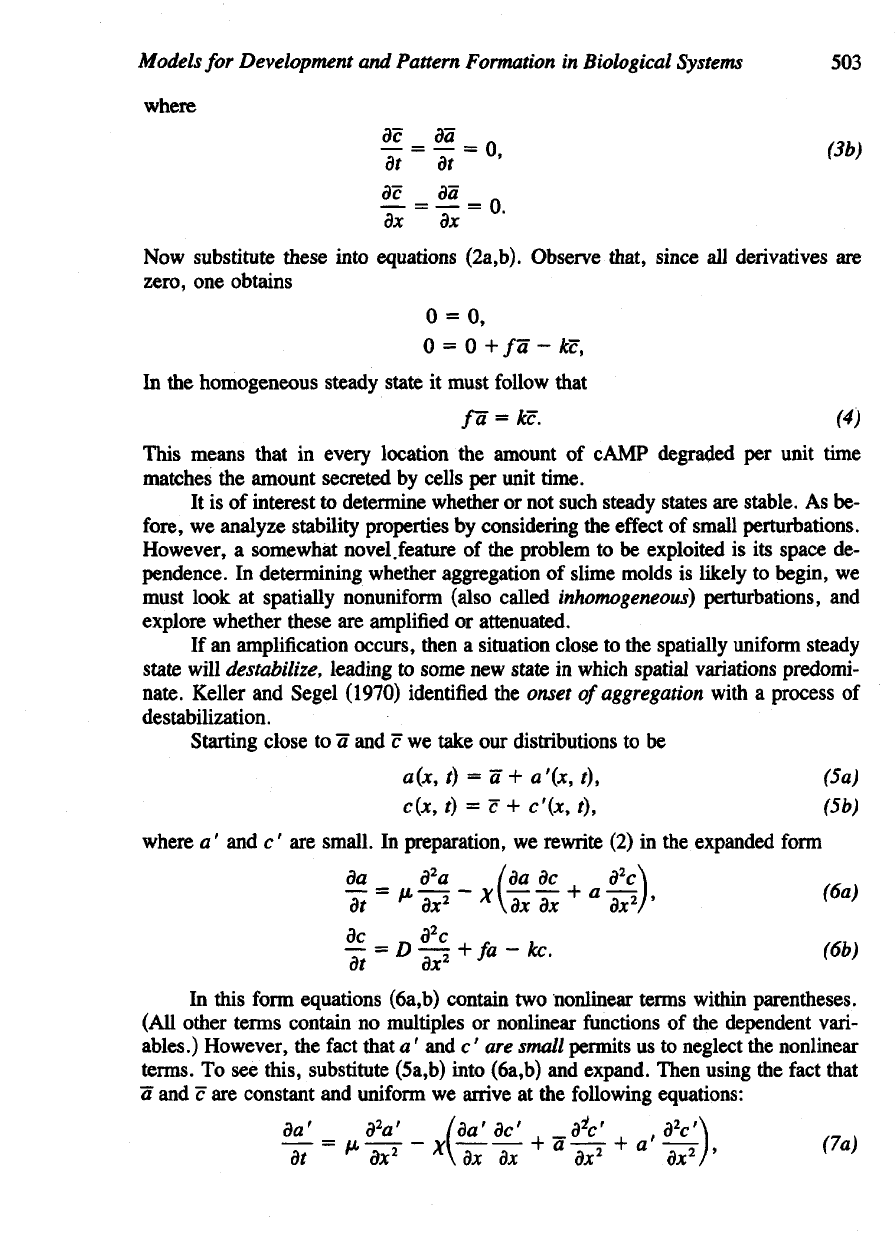
Models
for
Development
and
Pattern Formation
in
Biological
Systems
503
where
Now
substitute
these
into equations (2a,b). Observe that,
since
all
derivatives
are
zero,
one
obtains
In
the
homoge ous steady state
it
must follow that
This means that
in
every location
the
amount
of
cAMP degraded
per
unit time
matches
the
amount secreted
by
cells
per
unit
time.
It is of
interest
to
determine whether
or not
such steady states
are
stable.
As be-
fore,
we
analyze stability properties
by
considering
the
effect
of
small perturbations.
However,
a
somewhat novel.feature
of the
problem
to be
exploited
is its
space
de-
pendence.
In
determining whether aggregation
of
slime molds
is
likely
to
begin,
we
must
look
at
spatially
nonuniform
(also called
inhomogeneous)
perturbations,
and
explore whether these
are
amplified
or
attenuated.
If
an
amplification occurs, then
a
situation close
to the
spatially
uniform
steady
state will destabilize, leading
to
some
new
state
in
which spatial variations predomi-
nate. Keller
and
Segel
(1970) identified
the
onset
of
aggregation
with
a
process
of
destabilization.
Starting
close
to
~a
and c we
take
our
distributions
to be
where
a' and c' are
small.
In
preparation,
we
rewrite
(2) in the
expanded
form
In
this
form
equations (6a,b) contain
two
nonlinear terms within parentheses.
(All other terms contain
no
multiples
or
nonlinear
functions
of the
dependent vari-
ables.)
However,
the
fact
that
a' and c' are
small permits
us to
neglect
the
nonlinear
terms.
To see
this, substitute (5a,b) into (6a,b)
and
expand. Then using
the
fact
that
a
and c are
constant
and
uniform
we
arrive
at the
following equations:
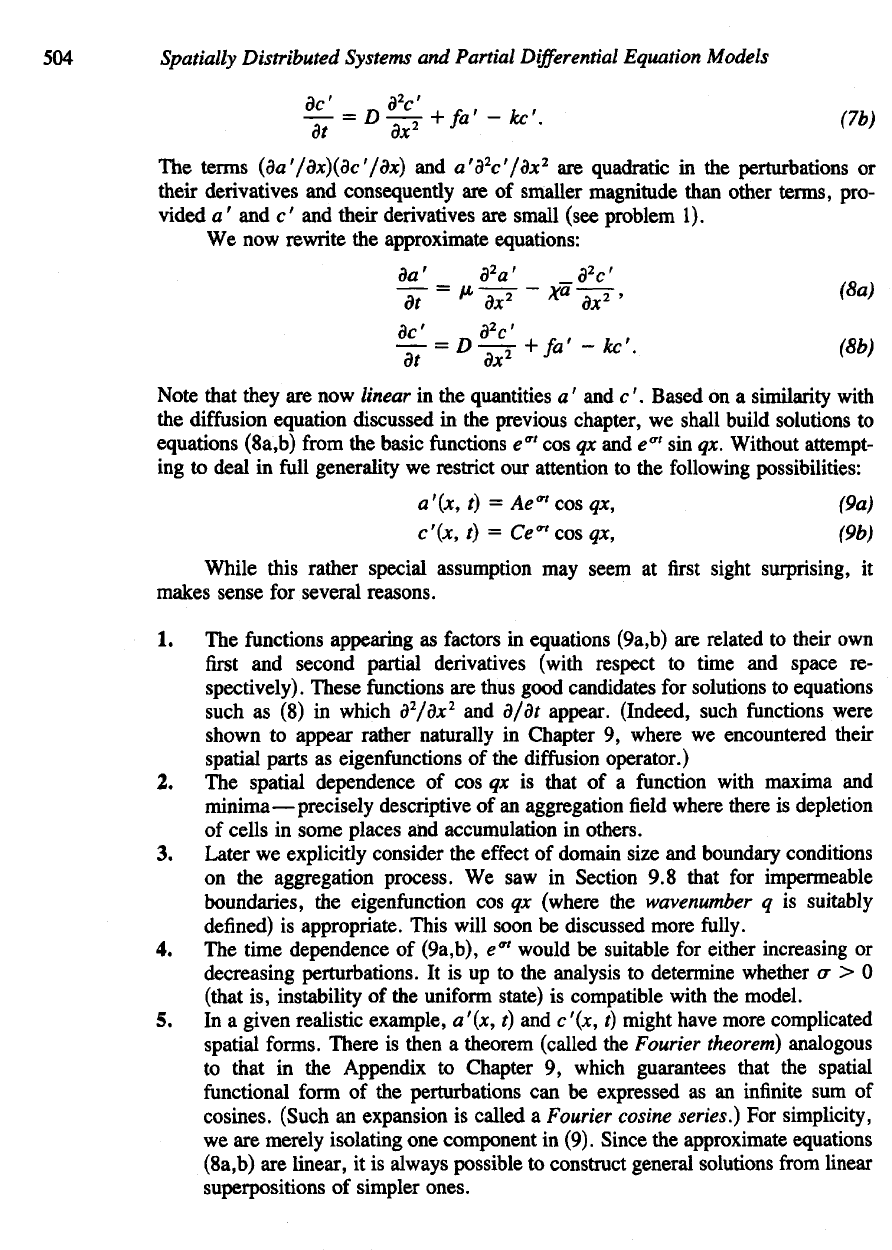
504
Spatially
Distributed
Systems
and
Partial
Differential
Equation
Models
The
terms
(da'/dx)(Bc'/dx)
and
a'd
2
c'/dx
2
are
quadratic
in the
perturbations
or
their derivatives
and
consequently
are of
smaller magnitude than other terms, pro-
vided
a' and c' and
their derivatives
are
small (see problem
1).
We now
rewrite
the
approximate equations:
Note that they
are now
linear
in the
quantities
a' and c'.
Based
on a
similarity
with
the
diffusion
equation discussed
in the
previous chapter,
we
shall build solutions
to
equations (8a,b)
from
the
basic
functions
e
at
cos qx and e
m
sin qx.
Without attempt-
ing
to
deal
in
full
generality
we
restrict
our
attention
to the
following
possibilities:
While this rather special assumption
may
seem
at first
sight surprising,
it
makes sense
for
several reasons.
1. The
functions appearing
as
factors
in
equations (9a,b)
are
related
to
their
own
first
and
second partial derivatives
(with
respect
to
time
and
space
re-
spectively).
These
functions
are
thus
good candidates
for
solutions
to
equations
such
as (8) in
which d
2
/dx
2
and
d/dt appear. (Indeed, such
functions
were
shown
to
appear rather naturally
in
Chapter
9,
where
we
encountered their
spatial parts
as
eigenfunctions
of the
diffusion
operator.)
2. The
spatial dependence
of cos qx is
that
of a
function
with
maxima
and
minima—precisely descriptive
of an
aggregation
field
where there
is
depletion
of
cells
in
some places
and
accumulation
in
others.
3.
Later
we
explicitly consider
the
effect
of
domain size
and
boundary conditions
on the
aggregation
process.
We saw in
Section
9.8
that
for
impermeable
boundaries,
the
eigenfunction
cos qx
(where
the
wavenumber
q is
suitably
defined)
is
appropriate. This will soon
be
discussed more
fully.
4. The
time dependence
of
(9a,b),
e"
would
be
suitable
for
either increasing
or
decreasing perturbations.
It is up to the
analysis
to
determine whether
cr > 0
(that
is,
instability
of the
uniform
state)
is
compatible with
the
model.
5. In a
given
realistic
example, a'(x,
t) and
c'(x,
t)
might have more complicated
spatial forms. There
is
then
a
theorem (called
the
Fourier
theorem]
analogous
to
that
in the
Appendix
to
Chapter
9,
which guarantees that
the
spatial
functional
form
of the
perturbations
can be
expressed
as an
infinite
sum of
cosines.
(Such
an
expansion
is
called
a
Fourier
cosine series.)
For
simplicity,
we
are
merely isolating
one
component
in
(9). Since
the
approximate equations
(8a,b)
are
linear,
it is
always possible
to
construct general solutions
from
linear
superpositions
of
simpler
ones.
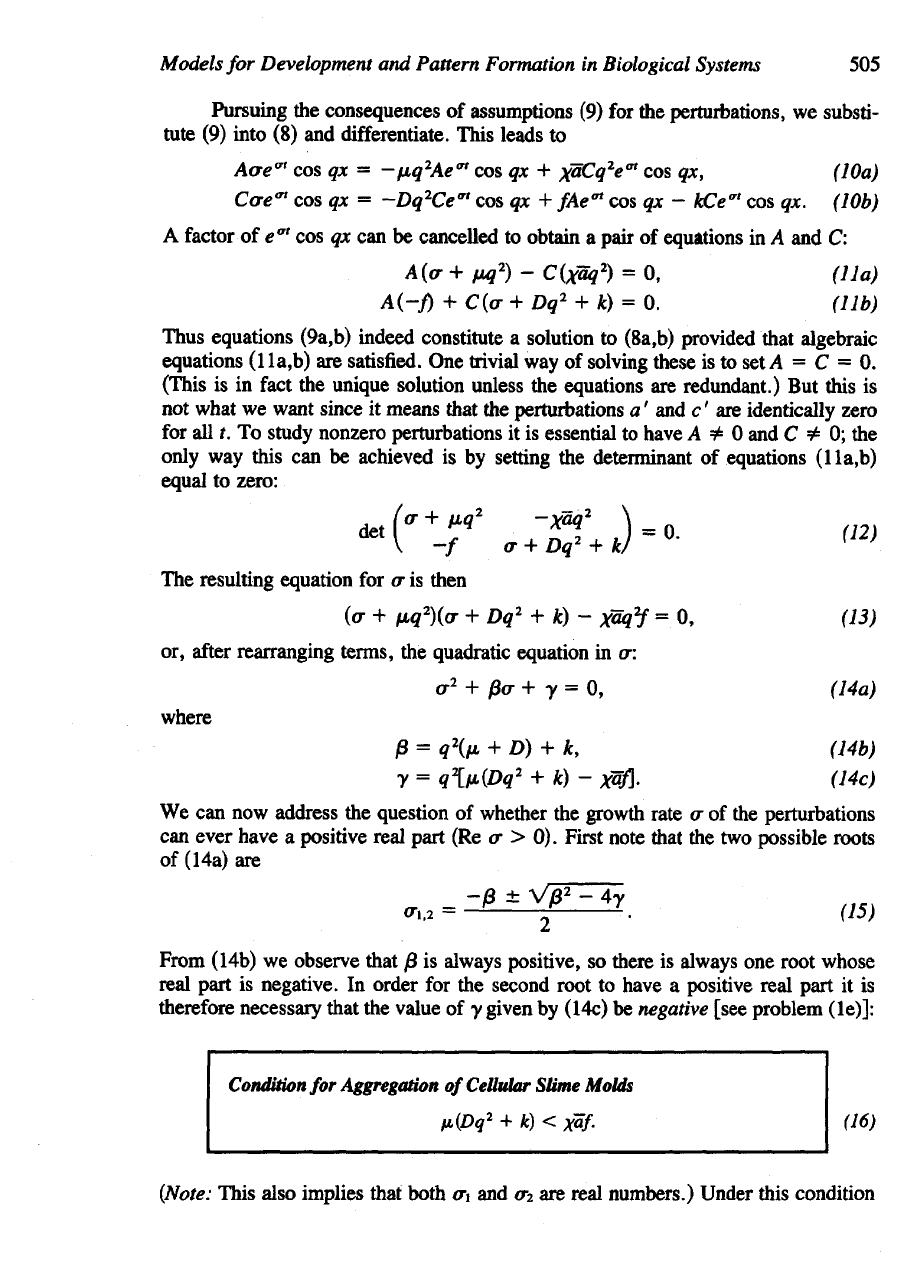
Models
for
Development
and
Pattern Formation
in
Biological
Systems
505
Pursuing
the
consequences
of
assumptions
(9) for the
pertur tions,
we
substi-
tute
(9)
into
(8) and
differentiate. This leads
to
A
factor
of e
m
cos qx can be
cancelled
to
obtain
a
pair
of
equations
in A and C:
Thus
equations (9a,b) indeed constitute
a
solution
to
(8a,b) provided that algebraic
equations
(1
la,b)
are
satisfied.
One
trivial
way of
solving these
is to set A = C = 0.
(This
is in
fact
the
unique solution unless
the
equations
are
redundant.)
But
this
is
not
what
we
want since
it
means that
the
perturbations
a' and c' are
identically zero
for
all t. To
study nonzero perturbations
it is
essential
to
have
A =£ 0 and C =£ 0; the
only
way
this
can be
achieved
is by
setting
the
determinant
of
equations
(lla,b)
equal
to
zero:
The
resulting equation
for a- is
then
or,
after
rearranging terms,
the
quadratic equation
in cr:
where
We can now
address
the
question
of
whether
the
growth rate
<r
of the
perturbations
can
ever have
a
positive real part
(Re a > 0).
First note that
the two
possible
roots
of
(14a)
are
From (14b)
we
observe that
j8 is
always
positive,
so
there
is
always
one
root whose
real part
is
negative.
In
order
for the
second root
to
have
a
positive real part
it is
therefore
necessary that
the
value
of y
given
by
(14c)
be
ne tive
[see problem
(le)]:
Condition
for
Aggregation
of
Cellular Slime Molds
(Note:
This
also
implies
that both
a\ and cr
2
are
real numbers.) Under this condition
